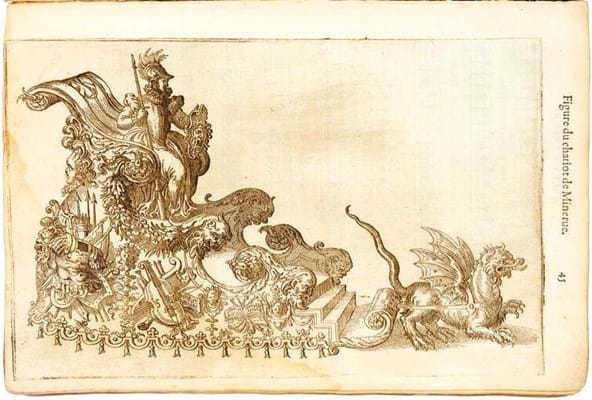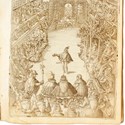It was a 1582 Paris first of a work that describes the Balet Comique de la Royne performed the previous year for the wedding of the Duc de Joyeuse and Marguérite de Vaudemont.
The Nottingham saleroom described it as complete with all engraved illustrations, musical notation, etc, and bound in later (possibly 18th century) blue paper wrappers.
Created at the behest of Louise de Lorraine, Marguérite’s sister and Henri III of France’s queen, the work is regarded as the first court ballet.
The Balet Comique… combines poetry, music, design and dance and takes as its theme the enchantment of Ulysses and his companions by a sorceress of Greek mythology, Circe.
Choreographed by Balthasar de Beaujoyeux (a dancing master whose real name was Baltazarini), it was performed before the French royals and nobles in the great Salle Bourbon of the old Louvre palace.
Over five hours long
Despite a running time of over five hours and ending at three o’clock in the morning, this ambitious production proved both successful and influential.
Featuring printed music and engraved illustrations by Jacques Patin, a court painter, the work on offer was accompanied by letters to or from the British Library, Sotheby’s and Christie’s, and contained a manuscript note of 1911 saying that it had been “valued by Mr Quaritch at £80”.
This was a copy that had not been seen on the market for over 100 years, said the auction house, but auction records do show three other copies sold in the last 30 or so years.
The most recent of them was the copy in the Splendid Ceremonies library of Paul & Marianne Gourary, a magnificent collection of fêtebooks and works on other ceremonies and festivities of the Renaissance and Baroque periods that was dispersed at Christie’s New York in 2009.
The copy in that great collection, bound in contemporary vellum, sold in New York for $105,000 (then around £64,000).
Debt collected
Bid to £2200 at the April 11 sale in Nottingham was a 1633 first of a comedy by Philip Massinger, A New Way to Pay Old Debts – a play that was “…often acted at the Phoenix in Drury-Lane, by the Queenes Maiesties servants”.
Close cropped in places, occasionally affecting signatures but not the text, it was in a much later Bayntun of Bath binding of blind-panelled calf with inner gilt dentelles.
Autograph highlights of this sale included cut signatures of two English monarchs. Bid to £1900 was the familiar, grandly flourished signature of Elizabeth I, while a bold example of that of Mary Tudor as ‘Marye the Quene’ made £850.
Sold for £450 was a three-part lot that focused on the radical journalist and politician John Wilkes.
It comprised a 1773, second edition of Joseph Cradock’s Life of John Wilkes, an anonymous 1768 Narrative of the Proceedings against John Wilkes and an unspecified Wilkes-related pamphlet.
One of 170 copies of a 1919 Harrap edition of Poe’s Tales of Mystery and Imagination sold at £1900. The upper board of the publisher’s full cream vellum gilt binding was bowed and there was some browning to the front endpaper and half title, but it was an otherwise good copy.
In the original dust jacket and generally well preserved overall, a 1926 Hogarth Press first of The End of Laissez-Faire by the economist John Maynard Keynes sold at a record £750.

















